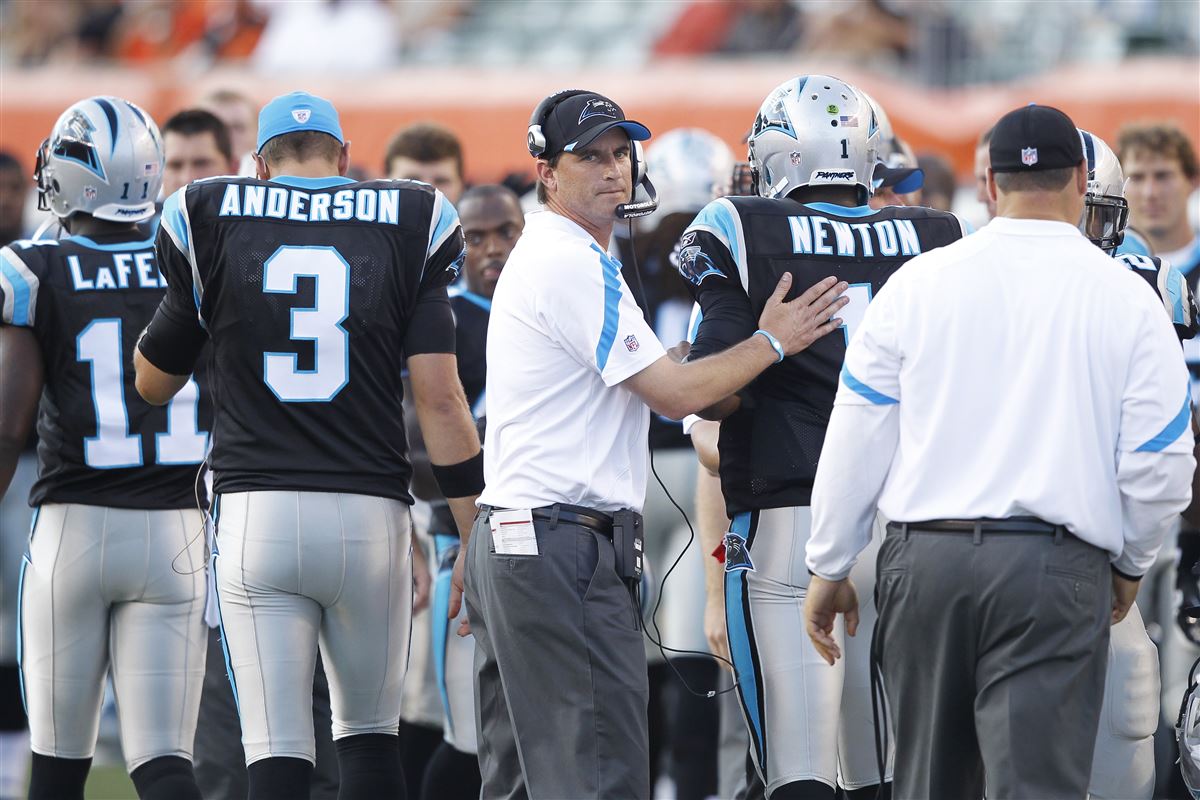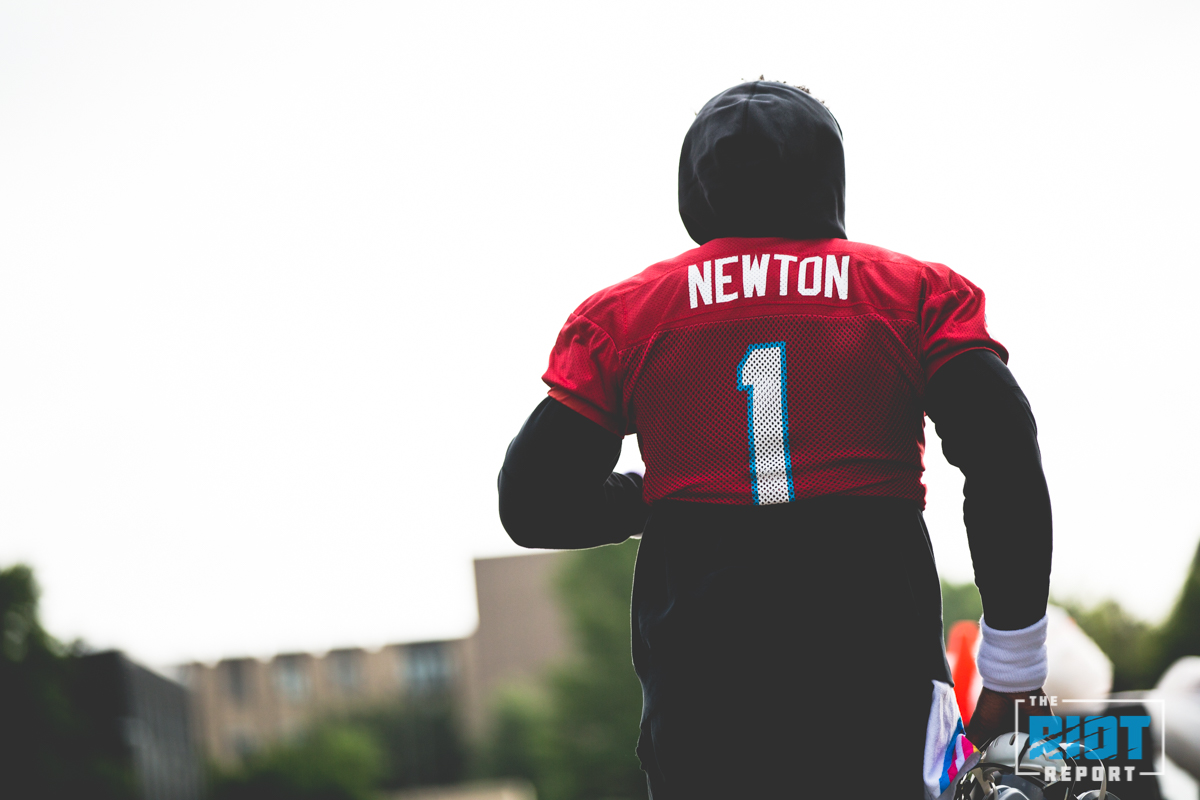I can’t say why Kelvin Benjamin chose to say what he said last weekend. I can’t speak to who he is as a person or what he might be going through – but I do know that what he said was (at best) wrong, and (at worst) delusional.
In his comments, Benjamin made three assertions: that Cam Newton isn’t one of the “quarterbacks with knowledge”, isn’t an “accurate quarterback like [Aaron] Rodgers or Eli Manning or Big Ben” and that he, Benjamin, would have fared better elsewhere. The first of these is hard to tie down, as the only way to judge a quarterback’s level of knowledge is through his ability to perform on the field. In that vein, now would probably be a good time to point out that in a season-and-a-half without Benjamin since 2014, Newton scored 60 total touchdowns against 20 turnovers. Even in the playoffs without Benjamin, Newton has seven touchdowns and four turnovers. In fact, in the 24 games without the Panthers’ 2014 first round pick, Newton’s Net Score – total touchdowns minus total turnovers – per game would be the second best all-time, slightly behind Tom Brady. So yes, Cam Newton might not be equal to the greatest quarterback of all time, but that is probably the strongest criticism one can make of Newton in terms of his production; oh, and even with Benjamin and all the offensive line and coaching issues he has thus far experienced, Newton is still third all-time in total touchdowns through the first seven seasons, behind some guys you may have heard of named Manning and Marino.
So if Cam’s numbers are so stellar, how come there are so many who question how good he is? The answer, at least the one that involves things on the football field, usually comes down to one number: completion percentage – and by extension, the idea of accuracy. Cam Newton’s career completion percentage is 58.5, having only broken the 60% barrier twice in his seven seasons and not once since 2013.
At a very simplistic level, that would suggest that Newton is not only highly inaccurate but actually getting worse by the year; however, what this fails to take into account is what completion percentage actually represents, and why it is not a fair representation of accuracy. Completion percentage, for example, cannot take into account how the quality of surrounding talent plays into the result of a given pass nor the effect of scheme on the relative difficulty of the throws a given player is asked to attempt. The latter can be summed up fairly simply – some offensive schemes ask the quarterback to attempt a higher proportion of deep passes and as the longer the throw, the more difficult it becomes to be accurate, the completion percentage should be expected to drop, with the effect being even more severe for quarterbacks who struggle for arm strength. While Newton doesn’t struggle in that regard, the offense he had been asked to run under Mike Shula since 2013 asked him to attempt a significant number of deep throws; in 2016, for example, over two-thirds of Newton’s throws traveled further than five yards downfield, a number which led the NFL by a comfortable margin.

Photo: Getty Images
Even if Cam is well above the league average in terms of completing these deep throws, his completion percentage will never be higher than those quarterbacks who are asked to do most of their work within five yards of the line of scrimmage. OK, but even if the effect of coaching is obvious enough, how can surrounding talent make such an impact on completion percentage?
The effect of surrounding talent can affect completion percentage in several ways, with some being easier to see than others. Most obviously, if a receiving corps struggles with drops, that will decrease the quarterback’s completion percentage; in 2016 for example, if you replace all the drops the Panthers experienced with completions, Newton’s completion percentage jumps from a worrying 52.9% to a far more respectable 64.4% and yes, I have checked the math on that and it really can make that big a difference.
Of course, other teams also have receivers that drop passes, and given the increase in completion percentage Newton would have experienced in 2016, this means that completion percentage as we view it today is rendered almost completely meaningless through drops alone. With a similar logic, receivers can also increase a quarterback’s completion percentage by ‘creating’ receptions that would typically fall incomplete; this is particularly relevant when it comes to contested catches on routes where the route doesn’t naturally generate an open target, such as fades. This is harder to chart than drops, but the effect can be just as significant. However, surrounding talent can effect completion percentage in other ways that just drops and created catches.
Some of this can be seen in how Newton’s completion percentage changed with time. During his first three seasons, Newton had his two best seasons in terms of completion percentage and the effect of Steve Smith on this cannot be overstated. Almost all receivers can get open against zone, especially with time, and faster receivers can usually get open deep at least competently, but the real value of receivers comes in their ability to separate underneath against man coverage; something that will be touched upon more a little later in this article. Steve Smith was one of the best receivers in NFL history at this, and if you go back and watch the tape from Newton’s first three seasons, his first in particular, the separation that Smith was able to get on a consistent basis is truly remarkable and not something that Newton has seen the like of since. Receivers are not really open or covered facing man coverage in the NFL, but rather occupy some point on a spectrum of separation – the more open a receiver is, the easier it is to complete the pass.
Newton has spent much of his career trying to force the ball into tight windows as his receivers struggled to separate and his completion percentage will have almost certainly dropped as a result. An excellent example of this is the playoff game against the Saints last season, where Newton’s display-for-the-ages of high level accuracy could only drag a threadbare receiving corps to a narrow loss and a 60% completion rate.
Pass protection and the running game can both also play a part on completion percentage, one more obvious than the other. A poor offensive line will allow pressure to get to the quarterback more quickly – and completion percentage has as much to do with decision-making as accuracy, something that is not made easier by a number of big burly men running at you with bad intentions. Despite being one of the most elusive quarterbacks in NFL history with a remarkable ability to avoid sacks, Newton is the third most sacked quarterback in the NFL since entering the league – as the Panthers’ offensive line has struggled with injuries and poor play; none of which will have helped his completion percentage. Since Newton was drafted, the Panthers have started 23 different offensive linemen.
Of course, Cam Newton has floors as all players do, and there are areas where it would be nice to see him continue to improve, but to pretend that, when healthy, he is not one of the very best quarterbacks to play this game is to hold that opinion in direct contradiction with the available evidence. Kelvin Benjamin, admittedly, is likely not using that evidence in making his judgements, and in many ways it is hard to have much ill feeling towards Benjamin for his comments. After all, he would hardly be the only person to argue that Cam isn’t among the NFL’s elite based on a failure to understand how outside factors can impact the superficial performance of a given player. Any evidence-based assessment has Newton well on track for the Hall of Fame – the amount of current NFL records Newton holds is insane and will only grow as he continues to rack up statistics. While there will always be those who find some perceived fault, be it a towel over his head or an interesting fashion sense, those people are probably best ignored, even if that involves turning the commentary off the next time you watch a Panthers game.



